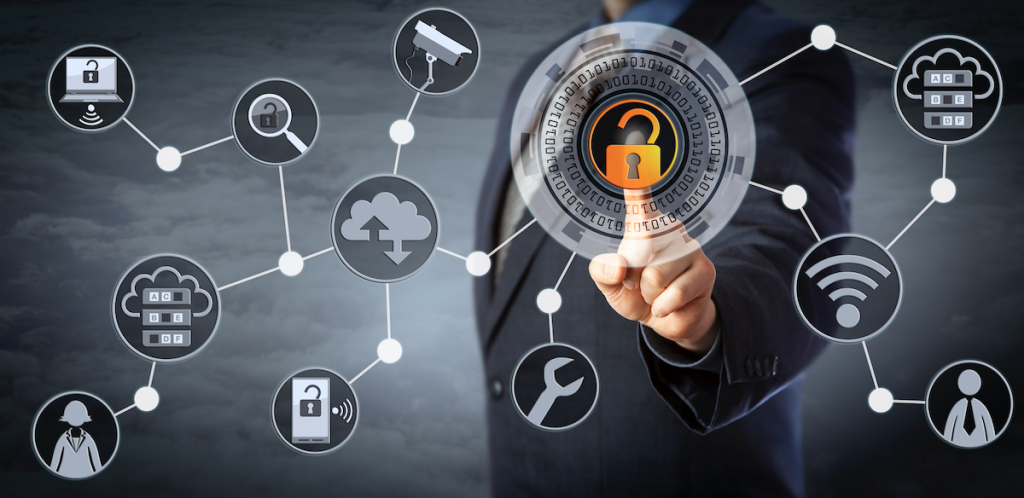
Features
Enhancing access control for workplace management
March 1, 2022 By Eric Talley
 LeoWolfert / iStock / Getty Images Plus
LeoWolfert / iStock / Getty Images Plus Maintenance closets storing cleaning supplies and government vaults protecting national secrets each have security needs.
However simple or complex they are, the physical access control of facilities risks neglect if innovation is ignored.
Thanks to advances in access control, implementing modern technological systems can be transformative not just for security, but for workplace management as a whole. If there’s a benefit to glean from the past two years, it’s been the opportunity for innovation through the integration of health indicators to existing security systems.
Such new features include skin temperature analysis, symptom screening and additional advancements in automated visitor management. Advances like these and others below help organizations to oversee employee and visitor flow effectively and with greater efficiency. They help organizations safeguard their people and assets as this pandemic progresses and provide policies and governance for navigating unforeseen safety concerns in the future.
Access Control Integrations
Security systems already in place have likely been serving organizations adequately. As threats evolve, so should the systems meant to address them. Modern advances in electronic access control systems contain features that fit into existing systems.
Adding features and functionality is as simple as integrating software applications. This allows separate systems within the overall security program to communicate and work collaboratively to manage seamless control.
Incorporating these functions creates a robust and nimble security network.
● Directory Services
Utilizing an electronic access control system can effectively add a security layer if it’s not already incorporated within the current environment. These systems draw upon existing human resource and time and attendance data, as well as directory services like Active Directory and Azure AD. The resulting access control is user-friendly and reduces fail points when you are adding or removing employees.
● Video Management
Video management systems integrate with the physical access control structure and include features such as video verification — which is a function used to verify alarms when they trip due to an intrusion. Individual or multiple cameras and alarms are a feature of this type of setup. Beyond individual access, video management can apply a counting function that eliminates unauthorized access by anyone walking closely behind an authorized user. This function can also help manage space capacity limits, sending alerts when occupancy thresholds are met.
● Building & Visitor Management
Beyond security, modern access control systems can tie into a building management network, such as automated HVAC and lighting, to provide monitoring and control benefits. These systems also send a unique credential via smartphone to any visitor appointments or staff due to be on-site for only select periods. This code offers them access through security while also alerting their host upon arrival. Half of the battle in managing access to a facility are the protocols that a business puts in place. It is vital that your system can work in conjunction with these protocols while giving you the freedom to adjust them as you see fit.
● Health & Safety
Integrating skin temperature detection or health symptom screening wasn’t on the radar of most facility security specialists before the pandemic. Times change. Yet, electronic access control systems are ready to adopt these measures to better manage workspaces. Available features include push notifications for personnel to complete and submit mandatory health symptom surveys before arriving or gaining admittance. Skin temperature detection can also be integrated and serve as a security layer. When this integrated system identifies a symptom indicator, its configuration immediately alerts human resources and enables an automatic postponement or rescheduling of appointments. Push notifications also offer any next steps that the host recommends or requires, such as quarantine.
Future Security Demands
Access control has evolved dramatically. Historically designed to limit entry only, modern electronic access control systems are a dynamic toolset to manage modern spaces securely. Choosing modern setups capable of upgrading functionality allows property managers and entire enterprises alike to help protect business space, their brand and reputation.
Facility accommodation will transform as workplace demands change. What the catalysts for future change will be — a new COVID variant, an altogether different pandemic, new hybrid work combinations or some unforeseen influence still over the horizon — is anybody’s guess. Electronic access control systems hold the promise to evolve in unison with the demands placed on them.
Eric Talley is a strategic account manager at STANLEY Security.
Print this page
Advertisement
- Security Summit Canada 2022 Recap: Future of security and business growth
- Active Witness’ solution deployed at Victoria Royals home arena